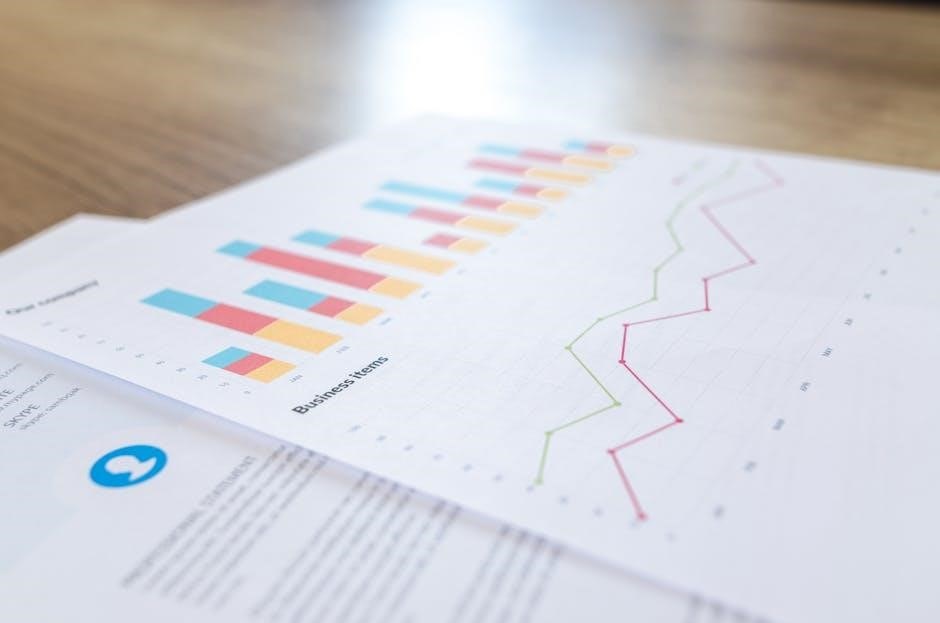The SECURE Act 2.0‚ signed into law in December 2022‚ aims to enhance retirement savings by expanding access and increasing flexibility for individuals and employers.
It builds on the original SECURE Act of 2019‚ introducing new provisions to improve retirement security and simplify plan administration for businesses of all sizes.
1.1 Overview of the SECURE Act 2.0
The SECURE Act 2.0‚ enacted in December 2022‚ is a comprehensive legislation designed to strengthen retirement security for Americans. It builds on the foundation of the original SECURE Act of 2019‚ introducing new provisions to expand access to retirement plans and enhance savings opportunities. The law focuses on improving retirement outcomes by increasing flexibility‚ simplifying plan administration‚ and encouraging employer-sponsored retirement programs. Key features include automatic enrollment‚ enhanced catch-up contributions‚ and expanded tax credits for small businesses. The Act also addresses challenges such as student loan repayments and emergency savings‚ while delaying the required minimum distribution (RMD) age. With a gradual rollout of provisions through 2028‚ the SECURE Act 2.0 aims to make retirement savings more accessible and sustainable for future generations.
1.2 Historical Context and Evolution
The SECURE Act 2.0 builds on the legacy of its predecessor‚ the SECURE Act of 2019‚ which introduced significant changes to retirement savings rules. The original SECURE Act aimed to expand access to retirement plans‚ modify required minimum distribution (RMD) rules‚ and simplify plan administration. SECURE Act 2;0 was enacted in December 2022 as part of the Consolidated Appropriations Act‚ 2023‚ with the goal of further enhancing retirement security. It addresses evolving challenges in retirement savings‚ such as increasing longevity and workforce dynamics. By expanding automatic enrollment‚ enhancing catch-up contributions‚ and providing incentives for small businesses‚ the SECURE Act 2.0 reflects a continued commitment to improving retirement outcomes for Americans. This legislation marks another step in the ongoing effort to modernize retirement policies and ensure financial stability for future generations.
1.3 Key Objectives of the Legislation
The SECURE Act 2.0 aims to enhance retirement security by expanding access to retirement plans‚ increasing savings rates‚ and improving flexibility for individuals and employers. A primary objective is to encourage greater participation in employer-sponsored retirement plans‚ particularly among small businesses and their employees. The legislation also seeks to reduce barriers to retirement savings‚ such as high plan administration costs and complex rules. Additionally‚ it focuses on promoting long-term financial stability by addressing issues like required minimum distributions (RMDs) and catch-up contributions. By simplifying retirement plan administration and offering tax incentives‚ the SECURE Act 2.0 strives to make retirement savings more accessible and sustainable for all Americans‚ ensuring a stronger financial future for generations to come.

Key Provisions of the SECURE Act 2.0
The SECURE Act 2.0 introduces provisions like automatic enrollment‚ expanded catch-up contributions‚ increased RMD age‚ Roth enhancements‚ and tax credits for small businesses to boost retirement savings.
2.1 Automatic Enrollment in Retirement Plans
The SECURE Act 2.0 mandates automatic enrollment for most new 401(k) and 403(b) plans starting in 2025‚ requiring employers to automatically enroll eligible employees with a default contribution rate of 3% to 10% of compensation. This provision aims to increase retirement savings rates by making participation easier for employees who might not otherwise enroll. Employers can opt out or adjust the contribution rate‚ but the default enrollment encourages consistent savings. This change applies to plans established after December 29‚ 2022‚ and is designed to help Americans build larger retirement nest eggs over time. Automatic enrollment simplifies the process and reduces administrative burdens for employers while promoting financial security for workers.
2.2 Expansion of Catch-Up Contributions
The SECURE Act 2.0 expands catch-up contributions for retirement plans‚ allowing individuals aged 50 and older to save more for retirement. The law increases the annual catch-up contribution limit for 401(k)‚ 403(b)‚ and governmental 457(b) plans to $10‚000 in 2024‚ with future increases tied to inflation. Additionally‚ Roth 401(k) and 403(b) plans now permit catch-up contributions on a Roth basis‚ providing tax-free growth opportunities. This change encourages older workers to maximize their retirement savings‚ especially as they near retirement age. The enhanced catch-up provisions take effect in 2024‚ offering greater flexibility for employees to boost their retirement accounts and employers to attract and retain talent. This expansion aims to address the retirement savings gap for older Americans.
2.3 Increase in Required Minimum Distribution (RMD) Age
The SECURE Act 2.0 increases the age for Required Minimum Distributions (RMDs) from retirement accounts. Starting in 2023‚ the RMD age rises from 72 to 73‚ and by 2033‚ it will increase to 75. This change applies to traditional IRAs and 401(k) plans‚ allowing individuals to keep their retirement savings invested longer. The updated RMD rules aim to reflect longer life expectancies and provide more flexibility for retirees. Roth 401(k) and 403(b) accounts are now exempt from RMDs‚ aligning them with Roth IRAs. This provision reduces the burden of annual withdrawals and allows accounts to grow tax-deferred for a greater period‚ benefiting retirees who wish to preserve their assets. The gradual phase-in of the higher RMD age ensures a smooth transition for affected individuals. This change is a significant step toward modernizing retirement rules.
2.4 Roth Retirement Account Enhancements
The SECURE Act 2.0 introduces significant enhancements to Roth retirement accounts‚ offering greater flexibility and tax advantages. One key provision eliminates Required Minimum Distributions (RMDs) for Roth 401(k) and 403(b) accounts‚ aligning them with Roth IRAs. This change allows Roth balances to grow tax-free indefinitely‚ benefiting retirees who wish to preserve wealth for future generations. Additionally‚ the law expands access to Roth contributions‚ enabling more workers to utilize these tax-free savings options. Enhanced catch-up contribution limits for Roth accounts further encourage retirement savings‚ particularly for those aged 50 and older. These improvements aim to simplify retirement planning and provide more opportunities for tax-advantaged growth‚ making Roth accounts more attractive for long-term financial security. Overall‚ these enhancements promote greater flexibility and tax efficiency for retirement savers.
2.5 Small Business Tax Credits for Retirement Plan Adoption
The SECURE Act 2.0 provides enhanced tax credits for small businesses to encourage the adoption of retirement plans. Employers with up to 50 employees can claim a tax credit of up to 100% of the costs associated with starting a retirement plan‚ such as administrative fees and setup expenses. Additionally‚ a new credit is available for contributions made to employees’ retirement accounts‚ further incentivizing plan adoption. These credits are designed to reduce the financial burden on small businesses‚ making it more affordable for them to offer retirement benefits to their employees. By expanding access to retirement plans‚ the legislation aims to increase retirement coverage and help more workers prepare for the future. This provision is particularly beneficial for smaller employers who may have previously found offering a retirement plan cost-prohibitive.
The SECURE Act 2.0 introduces Starter 401(k) plans‚ a new retirement savings option designed to make it easier for small businesses to offer retirement benefits. These plans require minimal administrative burdens and eliminate some traditional 401(k) complexities. Employers adopting a Starter 401(k) plan are not required to make contributions‚ and employees can contribute up to $6‚000 annually‚ with an additional $1‚000 catch-up contribution for those 50 or older. This provision aims to encourage small businesses to launch retirement plans by reducing costs and administrative hurdles. The Starter 401(k) plan is a significant step in expanding retirement savings opportunities for employees of small businesses.
2.7 Emergency Savings Accounts Linked to Retirement Plans
The SECURE Act 2.0 introduces a provision allowing employers to link emergency savings accounts to retirement plans‚ fostering short-term financial stability while promoting long-term savings. Employees can contribute a portion of their income to these accounts‚ which are often Roth IRA or taxable accounts‚ with funds accessible for immediate needs. Employers may offer matching contributions or incentives to encourage participation. A key feature is the ability to transfer excess emergency savings into the retirement plan‚ helping to preserve long-term savings. This provision aims to reduce the need for retirement account loans and improve overall financial resilience. It is particularly beneficial for workers who struggle to balance emergency funds with retirement contributions.
2.8 Student Loan Repayment Contributions
The SECURE Act 2.0 includes a provision that allows employers to make matching contributions to retirement plans based on employees’ student loan payments. This innovative feature helps individuals save for retirement while paying off student debt. Employees can direct a portion of their income toward student loans‚ and employers can match these payments into a retirement account‚ such as a 401(k) or 403(b). This provision aims to encourage younger workers to start saving for retirement earlier‚ even as they manage significant student loan obligations. It also provides employers with a tool to attract and retain talent by offering a unique retirement benefit. This change is particularly beneficial for employees who might otherwise delay retirement contributions due to debt.
2.9 Annuity Provisions for Guaranteed Income
The SECURE Act 2.0 includes provisions designed to promote the use of annuities within retirement plans‚ offering participants a guaranteed income stream in retirement. These changes aim to enhance the availability of lifetime income options‚ providing retirees with greater financial security. Employers are encouraged to include annuity options in their 401(k) or other defined contribution plans‚ with safeguards to protect plan sponsors from fiduciary risks. This provision helps address the challenge of outliving retirement savings‚ ensuring a predictable income source. By facilitating access to annuities‚ the Act supports better retirement planning and financial stability for individuals. This approach aligns with the broader goal of improving retirement outcomes for Americans.

Impact on Employer-Sponsored Retirement Plans
SECURE Act 2.0 introduces automatic enrollment‚ tax credits‚ and simplified administration‚ encouraging employers to enhance retirement offerings and expand plan accessibility for employees.

3.1 Mandatory Automatic Enrollment for New Plans
Starting in 2025‚ the SECURE Act 2.0 requires most new 401(k) and 403(b) plans to automatically enroll eligible employees‚ with a default contribution rate between 3% and 10%. Employees can opt out if they choose. This provision aims to increase retirement savings rates‚ particularly among workers who might not enroll otherwise. Employers must also automatically escalate contributions annually‚ though this can be capped. Existing plans are exempt unless they adopt the new features. This change encourages consistent saving habits and helps employees build retirement security over time. It aligns with the broader goal of enhancing retirement preparedness for American workers.
3.2 Simplified Disclosure Requirements
The SECURE Act 2.0 introduces streamlined disclosure requirements to reduce administrative burdens on employers. Plan sponsors are now allowed to provide consolidated annual disclosures for multiple retirement plans‚ simplifying communication for participants. Additionally‚ the act permits electronic delivery of certain disclosures by default‚ enhancing convenience and reducing costs. These changes aim to make retirement plan administration more efficient‚ particularly for small businesses‚ while ensuring that participants remain well-informed about their benefits. By modernizing disclosure practices‚ the legislation encourages broader adoption of retirement plans and fosters greater employee engagement in retirement savings efforts; This provision reflects a broader effort to make retirement planning more accessible and manageable for both employers and employees.
3.4 Reduction of Penalties for Incorrect RMDs
The SECURE Act 2.0 reduces the penalty for failing to take required minimum distributions (RMDs) from 50% to 25% of the shortfall. This change aims to alleviate the burden on individuals who inadvertently miss RMD deadlines or miscalculate their distributions. The law also provides a self-correction mechanism‚ allowing participants to address errors without formal IRS approval‚ provided the issue is resolved promptly. This provision is effective for taxable years beginning after December 31‚ 2022. By reducing penalties and simplifying correction processes‚ the Act encourages compliance while minimizing punitive measures for unintentional mistakes. This change aligns with the broader goal of making retirement planning more accessible and forgiving for Americans.
3.5 Expansion of Multiple Employer Plans (MEPs)
The SECURE Act 2.0 expands access to Multiple Employer Plans (MEPs)‚ allowing unrelated employers to join together to offer retirement plans more easily. This provision simplifies the rules for MEPs‚ reducing barriers for small businesses to participate. The Act also introduces a new type of MEP called a “starter MEP‚” which requires minimal administrative effort and lower costs. Additionally‚ the law eliminates the “one bad apple” rule‚ which previously penalized all employers in an MEP if one failed to meet compliance standards. These changes aim to increase retirement plan availability for employees of small businesses‚ making it simpler and less risky for employers to offer retirement benefits through MEPs. This expansion is a key step toward improving retirement access for more workers.

Changes Affecting Individuals
The SECURE Act 2.0 introduces enhanced flexibility for individuals‚ including increased catch-up contributions‚ expanded Roth account options‚ and delayed RMD requirements‚ promoting better retirement preparedness and financial security.
4.1 Increased Flexibility for Retirement Savings
The SECURE Act 2.0 enhances flexibility for retirement savings by allowing individuals to make Roth IRA contributions regardless of income level and expanding catch-up contributions to $6‚500 in 2024.
Additionally‚ it introduces a new “catch-up” limit for those aged 60 to 63‚ enabling higher contributions to retirement accounts‚ thereby boosting savings potential for near-retirees.
These changes aim to address the retirement savings gap and provide more opportunities for individuals to secure their financial futures effectively.
4.2 Enhanced Catch-Up Contribution Limits
The SECURE Act 2.0 introduces enhanced catch-up contribution limits‚ increasing the annual catch-up amount to $6‚500 for 2024‚ with future adjustments for inflation.
Individuals aged 60 to 63 can now contribute an additional $6‚500 above the standard limit‚ providing a significant boost to retirement savings for near-retirees.
This provision aims to help older workers catch up on retirement savings‚ addressing the challenges of inadequate retirement funds and promoting financial security in later life.
4.3 Roth IRA Provisions and RMD Rules
The SECURE Act 2.0 modifies Roth IRA and RMD rules‚ enhancing flexibility for retirement savings and distributions.
Roth 401(k) and 403(b) accounts are now exempt from RMDs‚ aligning them with Roth IRAs‚ while traditional IRAs and 401(k)s still require RMDs starting at age 73.

Additionally‚ Roth IRA contributions can now include after-tax dollars‚ offering tax-free growth and withdrawals‚ and providing more options for tax diversification in retirement planning.
4.4 Portability of Retirement Accounts
The SECURE Act 2.0 improves the portability of retirement accounts‚ making it easier for individuals to transfer retirement funds between plans.
Provisions allow for smoother consolidation of accounts‚ reducing fragmentation and enhancing the ability to manage retirement savings more effectively.
Additionally‚ the Act simplifies the process of transferring retirement funds‚ ensuring that individuals can maintain their retirement savings even when changing jobs or plans.
This increased portability helps reduce administrative burdens and fees‚ enabling better long-term retirement planning and financial security.
These changes aim to make retirement accounts more adaptable to individuals’ evolving needs‚ ensuring they can maintain consistent retirement strategies throughout their careers.
Key provisions related to portability are set to take effect in 2024‚ further enhancing flexibility for savers.

Specific Provisions for Small Businesses
The SECURE Act 2.0 offers tax credits for plan adoption‚ simplified administration‚ and incentives to encourage small businesses to provide retirement benefits to their employees effectively.
5.1 Tax Credits for Plan Adoption
The SECURE Act 2.0 provides enhanced tax credits to small businesses for adopting retirement plans‚ aiming to reduce costs and incentivize plan implementation. These credits cover startup costs and administrative fees‚ making it more affordable for employers to offer retirement benefits. The credits are particularly beneficial for businesses with fewer employees‚ encouraging greater participation and coverage. This provision aligns with the broader goal of expanding retirement plan accessibility and promoting financial security for workers. By easing the financial burden‚ the Act encourages small businesses to play a more active role in supporting their employees’ long-term financial well-being.
5.2 Simplified Plan Administration
The SECURE Act 2.0 introduces streamlined administrative processes for retirement plans‚ reducing complexity and administrative burdens for employers. This includes simplified disclosure requirements and fewer regulatory hurdles‚ making it easier for businesses to manage and maintain retirement plans. Additionally‚ the Act promotes the use of automated systems and standardized procedures‚ which can enhance efficiency and compliance. These changes are particularly advantageous for small businesses‚ which often have limited resources to devote to plan administration. By simplifying these processes‚ the Act encourages more employers to offer retirement plans‚ ultimately benefiting both businesses and their employees. This provision underscores the legislation’s focus on increasing accessibility and reducing barriers to retirement savings.
5.3 Incentives for Plan Participation
The SECURE Act 2.0 includes provisions designed to incentivize employee participation in retirement plans. One key feature is the expansion of tax credits for small businesses‚ which helps offset the costs of establishing and administering retirement plans. Additionally‚ the Act introduces measures to make retirement savings more appealing to employees‚ such as allowing employers to offer emergency savings accounts linked to retirement plans. These incentives aim to increase employee engagement and encourage greater participation in retirement savings programs. By making retirement plans more accessible and beneficial‚ the Act helps employees build a more secure financial future while reducing the administrative burden on employers. This approach aligns with the broader goal of enhancing retirement readiness for all Americans.

Effective Dates and Implementation Timeline
The SECURE Act 2.0 provisions are being implemented gradually‚ with key changes taking effect in 2024 and continuing through 2028‚ ensuring a smooth transition for employers and employees.
6.1 Key Dates for Provisions Taking Effect
The SECURE Act 2.0 includes a staggered implementation timeline‚ with various provisions becoming effective in different years. Key dates include:
- 2023: New rules for Roth retirement accounts‚ removing RMD requirements for Roth 401(k) and 403(b) plans.
- 2024: Expansion of catch-up contributions for older workers and the introduction of emergency savings accounts linked to retirement plans.
- 2025: Mandatory automatic enrollment for new 401(k) and 403(b) plans‚ with a default contribution rate of 3-10%.
- 2025: Increase in the RMD age to 73‚ delaying the start of required distributions.
These changes are designed to enhance retirement savings options and simplify plan administration‚ with full implementation continuing through 2028.
6.2 Gradual Rollout of Changes Through 2028
The SECURE Act 2.0 provisions are implemented gradually‚ ensuring a smooth transition for employers and employees. By 2028‚ all changes will be fully effective.
- 2025-2026: Enhanced tax credits for small businesses and the introduction of starter 401(k) plans.
- 2027: Expanded eligibility for multiple employer plans (MEPs) to boost retirement coverage.
- 2028: Final adjustments‚ including additional increases in RMD age and full enforcement of automatic enrollment.
This phased approach allows stakeholders to adapt to new regulations‚ ensuring long-term retirement security for Americans while minimizing disruption.

Key Takeaways and Benefits
The SECURE Act 2.0 enhances retirement security by expanding access‚ increasing flexibility‚ and providing tax incentives‚ benefiting both individuals and employers nationwide.
7.1 Enhanced Retirement Security for Americans
The SECURE Act 2.0 significantly strengthens retirement security by introducing provisions that make saving easier and more accessible. It increases the RMD age‚ expands catch-up contributions‚ and simplifies plan administration‚ ensuring Americans can better prepare for their golden years. Enhanced flexibility in retirement accounts‚ such as Roth IRA improvements‚ allows for more strategic financial planning. Additionally‚ the Act promotes employer-sponsored plans‚ especially for small businesses‚ encouraging higher participation rates. These changes collectively aim to address the retirement savings gap‚ providing a more secure financial future for millions of Americans. By fostering a more inclusive and robust retirement system‚ the Act ensures that retirement savings are within reach for a broader population.
7.2 Increased Accessibility for Small Businesses
The SECURE Act 2.0 includes provisions that make it easier for small businesses to offer retirement plans‚ boosting accessibility for employers and employees alike. Tax credits for plan adoption and simplified administrative requirements reduce financial and operational barriers. The introduction of starter 401(k) plans and expanded Multiple Employer Plans (MEPs) enables smaller employers to provide retirement benefits more efficiently. These changes encourage more businesses to participate‚ helping their employees save for retirement. By lowering the hurdles for small businesses‚ the Act promotes a more inclusive retirement savings landscape‚ benefiting both employers and their workforce.
7.3 Improved Flexibility for Retirement Planning
The SECURE Act 2.0 enhances flexibility for retirement planning through expanded catch-up contributions‚ Roth account enhancements‚ and emergency savings options. Individuals can now contribute more to their retirement accounts‚ especially as they approach retirement age. Roth retirement accounts benefit from new rules eliminating required minimum distributions‚ allowing tax-free growth. Additionally‚ the Act permits linking emergency savings accounts to retirement plans‚ enabling participants to access funds without penalties for unexpected expenses. These provisions empower individuals to manage their retirement savings more effectively‚ adapting to life’s uncertainties while maintaining long-term financial goals. Overall‚ the Act offers more adaptable tools to align retirement strategies with personal and professional needs.
The SECURE Act 2.0 represents a significant step forward in enhancing retirement security‚ offering increased flexibility and accessibility for individuals and businesses‚ ensuring a stronger financial future.

8.1 Final Thoughts on the SECURE Act 2.0
The SECURE Act 2.0 marks a transformative effort to modernize retirement savings‚ addressing gaps in coverage and simplifying processes for both employers and individuals. By expanding access to retirement plans‚ enhancing catch-up contributions‚ and introducing measures like automatic enrollment‚ the legislation aims to foster greater financial security for future generations. Its focus on flexibility and inclusivity ensures that a broader range of Americans can benefit‚ particularly small businesses and their employees. As the provisions roll out‚ the impact on retirement preparedness is expected to be profound‚ setting a foundation for a more secure and stable retirement landscape across the nation.
8.2 Future Outlook for Retirement Savings
The SECURE Act 2.0 sets the stage for a promising future in retirement savings‚ emphasizing accessibility and adaptability. By encouraging automatic enrollment and expanding tax credits for small businesses‚ the legislation paves the way for more Americans to participate in retirement plans. Enhanced catch-up contributions and Roth account provisions further incentivize savings‚ while the gradual rollout of provisions ensures a smooth transition. As these changes take effect‚ the focus will remain on fostering a culture of preparedness and financial resilience. The long-term goal is to create a retirement system that is both equitable and sustainable‚ empowering individuals to secure their financial futures with confidence and stability.
